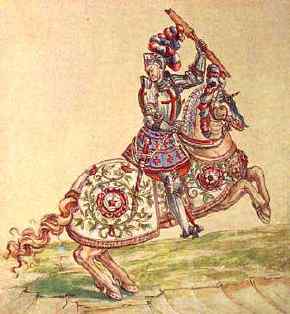Chivalry and the code of honour
Chivalry began as an ethic glorifying the martial values of medieval knights, a warrior elite which after the 10th century held a virtual monopoly on military and political power.
The knights held an exalted view of warfare and armed conflict as the testing-ground of true honour and nobility. They sought to excel in martial arts and to prove their courage in battle; the need to hone their skills in arms and horsemanship led to an emphasis upon peacetime activities such as hunting and formal tournaments. Other peacetime pursuits included the pursuit of suitably courtly ladies*.
There all the honour lies . . .
The danger was that honour would come to be seen as an attribute to be gained by physical prowess, rather than moral integrity:
The reputation and worth of a man consisteth in his heart and will; therein lies true honour
(Montaigne, Essays 1.30).
In Henry IV, Part One, Hotspur thinks of honour as something to pluck physically from the ocean or the moon, or to crop from Prince Hal's crest (see 1.3.199-206 and 5.4.70-71). Other figures in Shakespeare (Cassio, in Othello, Antony, in Antony and Cleopatra, Laertes in Hamlet) struggle with this same question; the whole play of Troilus and Cressida debates the meaning of honour--and comes close to suggesting that honour and arms are incompatible.
Perhaps the most moving statement of the importance of inner honour comes from Hermione, in The Winter's Tale, as she stands accused of adultery, and threatened with death:
But yet hear this--mistake me not: for life,
I prize it not a straw, but for mine honour,
Which I would free--if I should be condemned
Upon surmises, all proofs sleeping else,
But what your jealousies awake, I tell you,
'Tis rigour, and not law.
(3.2.107-12)
The Society for Creative Anachronism provides information on chivalry and the arts of combat.
Footnotes
-
Knights and ladies
The chivalric ethic came to represent an ideal code of moral, religious and social conduct--a code which continued to exert influence long after the armed and mounted knight became obsolete. The romantic literature of 12th and 13th century troubadours combined chivalric virtues with an idealized view of love.
In the tradition of courtly love, the ideal knight served and honoured a beloved lady (often worshipped from afar). But the conflicting duties of the knight to overlord, God, and lady placed strains on the chivalric ethic, particularly in the conflict between worldly and spiritual priorities.
